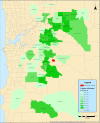Characterising a sarcoptic mange epizootic in quenda (Isoodon fusciventer)
- PMID: 35600220
- PMCID: PMC9114678
- DOI: 10.1016/j.ijppaw.2022.04.010
Characterising a sarcoptic mange epizootic in quenda (Isoodon fusciventer)
Abstract
Sarcoptic mange, a parasitic skin disease caused by Sarcoptes scabiei, is an emerging conservation threat to some Australian wildlife species. As a zoonotic and multi-host disease, it has the capacity to exploit different hosts, creating management challenges for susceptible wildlife populations that may suffer high rates of morbidity and mortality. Sarcoptic mange was identified in quenda (Isoodon fusciventer) in a peri-urban region of Perth, Western Australia in 2019. By mid-2021, reported cases were distributed across 107ha. This retrospective study reviews the spatiotemporal distribution, clinical signs and risk factors for sarcoptic mange in quenda from a metropolitan region. Preliminary epidemiological parameters for the outbreak are described, including period prevalence of infested individuals, spatiotemporal analyses, clinical signs of mange, and preliminary risk factor analyses. The period prevalence of sarcoptic mange between July 1, 2019 and June 30, 2021 was 26.9% (CI 95%; 21.2, 33.5) with a mortality rate of 39.6%, owing to severity of disease or secondary complications. Sarcoptic mange was detected more frequently in adult quenda than juveniles (OR: 176.8, CI 95%: 10.7, 2930.1), with adult males more affected than adult females (OR: 3.5, CI 95%: 1.5, 8.4). Clinical signs of disease presented on the rump and tail (100%), followed by the limbs and digits (61.5%). The most common clinical signs recorded were alopecia (92.3%), erythema (46.2%) and open wounds (42.3%). This is the first documented example of a geographically expanding and propagating epizootic of sarcoptic mange in quenda, with implicit welfare and conservation concerns for the species, alongside potential for cases in humans and domestic species that cohabit with or handle quenda in the urban environment. Further, the detection of cases through wildlife rehabilitation centres highlights the critical role such organisations play in conservation and passive surveillance for wildlife diseases of conservation or public and domestic animal health importance.
Keywords: Epidemiology; Isoodon fusciventer; Quenda; Sarcoptes scabiei; Sarcoptic mange; Zoonotic disease.
© 2022 The Authors.
Conflict of interest statement
None.
Figures








References
-
- Andriantsoanirina V., Ariey F., Izri A., Bernigaud C., Fang F., Charrel R., Foulet F., Botterel F., Guillot J., Chosidow O. Sarcoptes scabiei mites in humans are distributed into three genetically distinct clades. Clin. Microbiol. Infect. 2015;21:1107–1114. - PubMed
-
- Bazargani T.T., Hallan J.A., Nabian S., Rahbari S. Sarcoptic mange of gazelle (Gazella subguttarosa) and its medical importance in Iran. Parasitol. Res. 2007;101:1517–1520. - PubMed
-
- Broughton S.K., Dickman C.R. The effect of supplementary food on home range of the southern brown bandicoot, Isoodon obesulus (Marsupialia: Peramelidae) Aust. J. Ecol. 1991;16:71–78.
LinkOut - more resources
Full Text Sources
Research Materials

